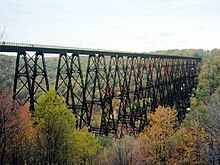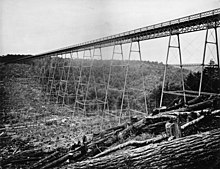Kinzua Bridge
The Kinzua Bridge (English Kinzua Bridge ) of the Erie Railroad in the north of the state of Pennsylvania in the United States in the Allegheny National Forest was 92 m high and 625 m long and was considered the second highest bridge in the United States (after the Pecos River High Bridge ). It was destroyed in a tornado on July 21, 2003 .
history
In order to develop the coal deposits in northern Pennsylvania near Brockway for customers in Buffalo and on the Great Lakes , decided the New York, Lake Erie and Western Railroad , a predecessor company of the Erie Railroad , a branch line from their main line New York - Cleveland to build. The greatest obstacle on the route starting in Carrollton was the Kinzua River valley. The bridge was designed by Adolphus Bonzano from the Phoenixville Bridge Works Company and Oliver W. Barnes from the railway company. It was designed and built by Octave Chanute . The work on the foundations, begun in 1881, took 6 months. The sandstone foundations have a volume of 5,810 m³. On April 10, 1882, the construction of the iron structure began. The construction was completed within 94 days by just 40 workers. The bridge cost $ 167,000 at the time and 1159 tons of iron were used. After completion, the building began to be marketed under the name “Eighth Wonder of the World”; the bridge was 301 ft (92 m) when it was completed and until the opening of the Garabit Viaduct in 1884, the highest railway bridge in the world and at the same time one of the longest. Special passenger trains were used across the bridge. With the associated income, the construction costs could be more than covered. When the United States entered the First World War, the pleasure rides ended.
In strong winds the bridge began to swing. The speed for passing trains was reduced to 8 km / h in such weather to prevent damage or an accident.
The bridge was rebuilt in 1900 to cope with the higher weights of locomotives and wagons. The iron construction was replaced by one made of steel. Construction work began on May 24, 1900 and on September 25, 1900 the line was opened to traffic again. Around 100 to 150 workers built around 2500 tons of steel. The chief engineer of the Erie Railroad CW Bucholz was responsible for the construction. Here, emphasis was also placed on improved resistance to strong winds.
The bridge was subsequently repainted every seven years. Between 1907 and 1933 the foundations of the bridge were coated with concrete. After the end of coal production in Pennsylvania, the route was no longer needed. On June 21, 1959, the last scheduled train drove over the route. In 1963 the bridge was taken over by the state of Pennsylvania and declared Kinzua Bridge State Park . The park opened in 1970. With the inclusion in the list of the National Historic Civil Engineering Landmark in 1975, the importance of the bridge was further recognized.
The Knox and Kane Railroad began operating tourist trains over the bridge from Marienville, Pennsylvania in 1987 . In 2001, the Pennsylvania Department of Transportation declared State Route 3011 the state's first scenic byway .
On June 27, 2002, due to the poor condition of the bridge, crossing with trains was prohibited; the bridge was placed on Pennsylvania's Most Endangered Objects list. On August 23, 2002, the bridge was also closed to pedestrians, as there was a risk that the bridge could become unstable in unfavorable winds. In the spring of 2003, repairs and renovation work began on the bridge. A tornado of magnitude F-1 on the Fujita scale collapsed eleven of the 20 pillars on July 21, 2003. The cause was the corroded and damaged connection between the bridge elements and the foundations, which had remained unchanged since 1882.
With an estimated cost of around 45 million dollars, a reconstruction was rejected by the state of Pennsylvania and did not come about through private initiatives. As a result, the bridge was removed from the National Register of Historic Places on July 21, 2004 .
The Kinzua Sky Walk
The Pennsylvania Department of Conservation and Natural Resources (DCNR) decided in 2005 due to the regional economic importance of Kinzua Bridge State Park , which had around 215,000 visitors annually before the bridge was destroyed and was listed among the top 20 state parks in Pennsylvania to stabilize the remaining parts of the bridge at the southern end and to use them as the basis for a possible viewing platform. In the course of this, the aging infrastructure of the Kinzua Bridge State Park should also be fundamentally renewed and expanded.
These plans were met by the fact that the operating company of the historic railway line, the Knox and Kane Railroad , had to cease operations in 2004, as it lost its most attractive section of the route and around 75% of its customers due to the collapse of the bridge. After the bankruptcy estate was taken over by a third party, the tracks on the two access routes to the bridge were removed from 2008 and sold as scrap. Due to the right-of-way , the remaining track can now be converted into a hiking or cycling path ( rail trail ) in the future.
The Kinzua Sky Walk was opened with a celebration on September 15, 2011 . The viewing platform is around 68.6 meters above the ground, has a glass floor and offers an imposing view over the Kinzua valley. On July 1, 2016, the Kinzua Bridge State Park's new Visitor Center opened with exhibits and shops covering the history of the area, local trades, handicrafts and environmental issues. The remaining remains of the destroyed bridge should give an impression of the forces of nature and remain as such.
Web links
- Kinzua Bridge State Park (English)
- Official report on the collapse of the bridge (English)
- Kinzua Bridge Foundation (English)
- Page with many photos of the bridge ( Memento from November 25, 2007 in the Internet Archive )
- Detailed Description of the bridge and the construction (English)
Coordinates: 41 ° 45 ′ 48.6 " N , 78 ° 35 ′ 20.9" W.




